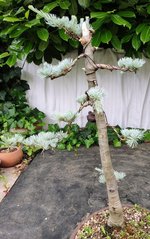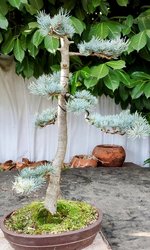You are using an out of date browser. It may not display this or other websites correctly.
You should upgrade or use an alternative browser.
You should upgrade or use an alternative browser.
Atlas Blue Cedar
- Thread starter Bonsaidoorguy
- Start date
Potawatomi13
Imperial Masterpiece
Perhaps tree would look better if center branch of top 3 on Rt side of tree removed .
.
I am in love with cedars, I hope you dont mind me making some questions as they can be helpful for the development of the thread tree.Ok... this is an Atlas Cedar. There’s some things you ought to know about them, because they are a little more difficult in some ways. (And easy in others!)
Their branches (wood) is very sappy and springy. You have to use really strong wire to be effective, because over time, they will revert back to the way they were. And the wire needs to stay on for a long time. And when you remove the wire, the branch will move back, and you’ll have to rewire it.
They DO back bud well wherever there’s foliage. They don’t back bud on old wood very well. Make sure when you cut back, there’s an active bud. BUT... cutting back WILL encourage back budding, and you can develop nice pads. It’s important to keep foliage close to the trunk, so cutting back will encourage the tree to grow close in branches, and not get “leggy”.
Now, when I look at your tree, I see you have wired with aluminum, which I strongly discourage for Atlas Cedar. The branches have enough spring in them to overpower aluminum. One of the things about using copper wire is that usually you can use thinner Copper than you would with aluminum. But Atlas Cedar is so springy, you should use heavy copper wire! Really.
See how your branches arch? You don’t want that. Assuming you want the branches to hang down, they should start moving down directly from the trunk. You say you couldn’t do that? Well, it’s because the wire wasn’t strong enough. Even using copper, you might need something extra. Take a look at the following diagram:
View attachment 371454
Look at Fig.16. A piece of rebar was tied to the bottom of the branch. Pad with rubber. The end of the rebar closest to the trunk is about 1/4 to 1/2 inch away from the trunk to give it room when it’s bent down. Then the branch is pulled down using the rebar. The guy wire holds it in place. What this does is use the length of the rebar as leverage, but puts all the bend right at the place where the branch joins the trunk. No arching. That rig will have to stay in place a couple of years. There might be some minor tearing of the tissue on the top of the joint. Put cut paste on. It will heal.
I hope this helps. Atlas cedars are more difficult to wire effectively than other conifers. They require heavier, stronger wire, and it takes more time to “set”. And count on having to remove and replace the wire every two years! Once you get the structure set up, then they are easy to maintain and develop ramification.
Good luck!
This is really great info, but I have some follow up questions. You mention that probably wire needs to be reapplied as the branches (and trunk if you are wiring it I guess) bounce back to their old position. I have a question about this everytime this is said. How do you ensure that the new wiring is shaping the branch in the same way as was before? Otherwise you would be bending a different section of the branch and they will never set? Or I am overthinking this and this is not so important as long as the general movement of the branch is the same?
I also have some doubts about this habit of Cedars to spring back to position. If you are positioning new growth instead of old branches, could you wire the shoot when it is still not lignified? If you do so, will the shape set easier and not spring back?
Going to be a little tough to wire just the new growth (think slow growers, very short) without wiring the whole branch. The info about having to rewire to get shape is correct.I also have some doubts about this habit of Cedars to spring back to position. If you are positioning new growth instead of old branches, could you wire the shoot when it is still not lignified? If you do so, will the shape set easier and not spring back?
Deep Sea Diver
Imperial Masterpiece
It’s just the innate structure of cedars and many other conifers to want to bounce back, flexing with the winter snow load, then springing back to the sun. A Mountain Hemlock is another good example of a very flexible conifer.
As you know, wiring is necessary to get the branch to set. In trees that are not so flexible, say a maple or an azalea, when the branch is bent, cells break and or are distorted. When the cells are repaired and hardened up in the new position one can take the wires off and the branch will have set. Thats because the cells have a much less flexible cell wall etc.. The cells didn’t need to flex in when they evolved, unlike conifers
( btw wiring slows the growth in the wired areas until the cells and pathways are restored…. this repair time varies widely by species and cultivar. )
Conifers process is very much the same, yet as the branches are flexible, so are the cell walls etc that make up the branch. Thus when the wire comes off, the branch wants to spring back…. a little less then before. After all evolutionarily the cells were created to do exactly. Thus it takes a number of wiring sessions to accumulate enough layers of new cells to reinforce a bend and keep it in the desired position.
So that’s why we wire, then rewire… and repeat to get the desired result.
I hope this explanation helps,
Cheers
DSD sends
As you know, wiring is necessary to get the branch to set. In trees that are not so flexible, say a maple or an azalea, when the branch is bent, cells break and or are distorted. When the cells are repaired and hardened up in the new position one can take the wires off and the branch will have set. Thats because the cells have a much less flexible cell wall etc.. The cells didn’t need to flex in when they evolved, unlike conifers
( btw wiring slows the growth in the wired areas until the cells and pathways are restored…. this repair time varies widely by species and cultivar. )
Conifers process is very much the same, yet as the branches are flexible, so are the cell walls etc that make up the branch. Thus when the wire comes off, the branch wants to spring back…. a little less then before. After all evolutionarily the cells were created to do exactly. Thus it takes a number of wiring sessions to accumulate enough layers of new cells to reinforce a bend and keep it in the desired position.
So that’s why we wire, then rewire… and repeat to get the desired result.
I hope this explanation helps,
Cheers
DSD sends
Cedar wood is full of sap. The sap keeps the actual wood soft, and soft wood bends easier. But it also makes it more difficult for the wood to retain that bend. The wood is simply “springy”. It bends without breaking. But then, it tends to revert to it’s original position.Thanks for the physiological reasoning for it. it makes sense.!
Hardwood trees are called that because the wood is hard! Lol!!! It tends not to bend, but if enough force is applied, it breaks. So, hardwood trees can be wired/bent until the wood is lignified, but once it’s lignified, if you try to bend it, you’re likely to break it, not bend it.
conifers keep more sap in their wood, which makes them “softwood” and more flexible. Cedars tend to to be “sappier” than pines, thus “softer”. And that means that bends take longer to set.
Bonsaidoorguy
Chumono
Well I took everyone's critique and suggestions to heart and decided that I'd bite the bullet and remove a few branches. One I just shortened and it still looks too thick, I think I might just remove it. I wanted to see what an apex would look like, not sure if I like it either. Pulled the branches down a little more too. 





Deep Sea Diver
Imperial Masterpiece
That’s a great first step! The first branch is always the hardest to part with imho.
I’ll be interested to watch your design evolve.
Sorta, that’s why … cells, etc... The additional sap merely adds ‘lubrication’ to the ‘matrix’. As you said “ trees can be wired/bent until the wood is (fully) lignified”.
It is correct that adding additional sap to the ‘matrix’ makes it harder to set…Yet the cells are evolutionarily more resilient…caused by the demands of their environment over millennia.
As a result more wiring rounds are needed to add repeated stress/breakage (internal cell distortion and micro fracture), to the branches …so the tree responds by repairing/replacing these cells and producing sufficient new layers of lignified cells to set a branch….
Cheers
DSD sends
I’ll be interested to watch your design evolve.
Cedar wood is full of sap.. Cedars tend to to be “sappier” than pines, thus “softer”.
And that means that bends take longer to set.
Sorta, that’s why … cells, etc... The additional sap merely adds ‘lubrication’ to the ‘matrix’. As you said “ trees can be wired/bent until the wood is (fully) lignified”.
It is correct that adding additional sap to the ‘matrix’ makes it harder to set…Yet the cells are evolutionarily more resilient…caused by the demands of their environment over millennia.
As a result more wiring rounds are needed to add repeated stress/breakage (internal cell distortion and micro fracture), to the branches …so the tree responds by repairing/replacing these cells and producing sufficient new layers of lignified cells to set a branch….
Cheers
DSD sends
Bonsaidoorguy
Chumono
Bonsaidoorguy
Chumono
Bonsaidoorguy
Chumono
Bonsaidoorguy
Chumono
Bonsaidoorguy
Chumono
Here in Seattle I have no problem getting moss to grow in my pots. In fact sometimes I'll remove all the moss on a tree when the birds just won't leave a certain tree alone. It works and the moss grows back.Looks great! What are you doing for moss?
Bonsaidoorguy
Chumono
Took off another thick branch neer the top that seemed out of place. Removed some wire and put some back on. Also pruned some of the stronger growing tips to distribute energy to some interior growth.
Attachments
Similar threads
- Replies
- 7
- Views
- 446














